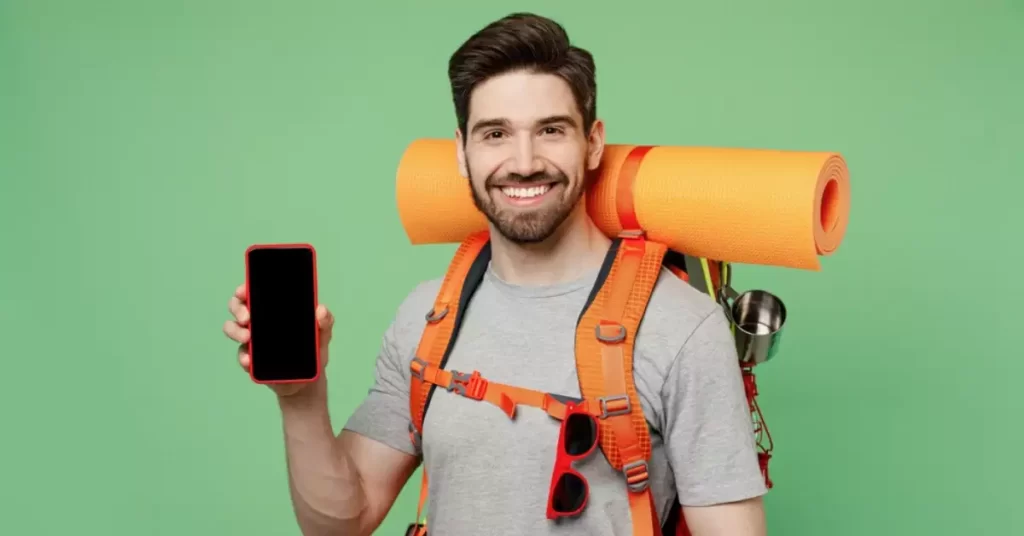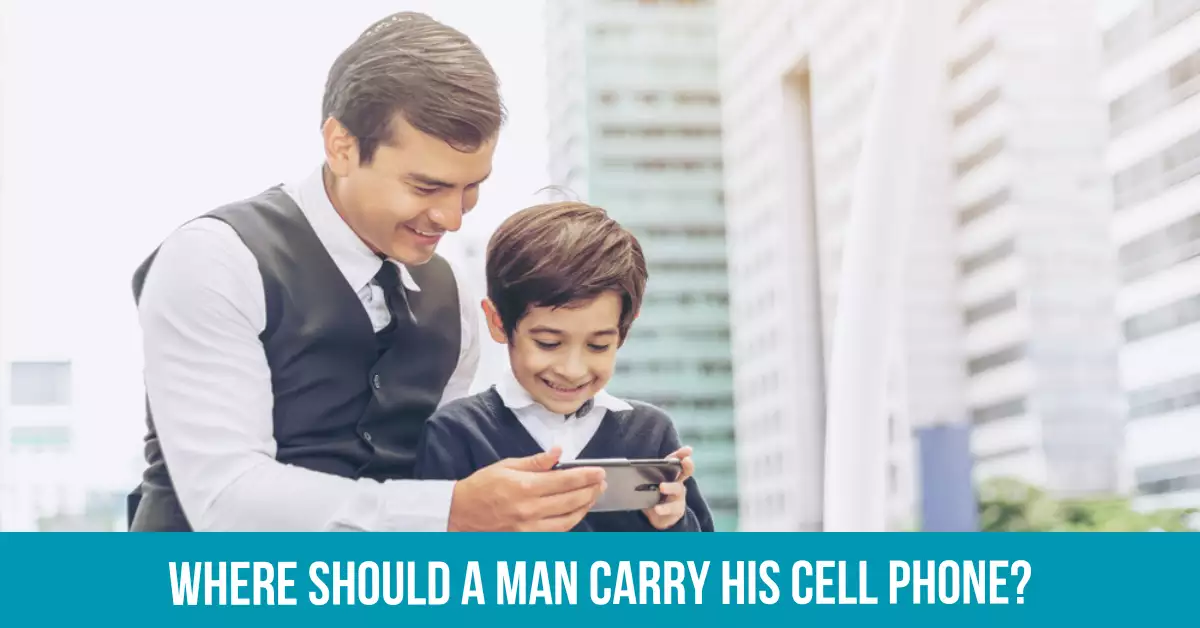In today’s world, cell phones have become an indispensable part of our daily lives. As such, it is crucial to figure out where to carry your cell phone, ensuring it is secure, easily accessible, and comfortable to wear.
This article explores various options for men to carry their cell phones and provides helpful tips and insights to help you make an informed decision.
Factors to Consider
Before deciding where to carry your cell phone, consider the following factors:
Comfort
You want to carry your phone in a way that feels comfortable throughout the day, especially if you are constantly on the move.
The location should not cause any discomfort or hinder your movements.
Accessibility
Your phone should be easy to reach when needed, especially if you use it frequently for calls, messaging, or other tasks.
Having to fumble around to find your phone can be frustrating and time-consuming.
Safety
Protecting your phone from damage, loss, or theft is essential. Ensure that the location you choose to carry your phone is secure enough to minimize these risks.
Popular Options for Carrying a Cell Phone
Several options are available for men to carry their cell phones. Some of the most popular choices include:
Front Pocket
Carrying your phone in your front pants pocket is a common choice. It provides easy access and reduces the risk of accidentally sitting on your phone, which could lead to damage.
Back Pocket
Although less common than the front pocket, some men prefer to carry their phones in their back pockets.
This option can be comfortable and accessible, but it comes with an increased risk of damage if you accidentally sit on your phone.
Jacket or Coat Pocket
If you often wear a jacket or coat, using an inner or outer pocket can be a practical solution. This option provides easy access, security, and comfort.
However, you must remember to transfer your phone when changing jackets or coats.
Bag or Backpack
For men who prefer not to carry their phones in their pockets, a bag or backpack can be a great alternative.
This method keeps your phone secure and protected but may not offer the same level of accessibility.
Smartphone Holster
A smartphone holster or belt clip allows you to securely attach your phone to your belt or waistband.
This option provides quick access and added security but may not be the most comfortable or stylish choice.
Phone Lanyard
A phone lanyard is a strap that can be worn around your neck or wrist, with a secure attachment for your phone.
This option offers easy access and security but may not be as comfortable or inconspicuous as other methods.

The Pros and Cons of Each Option
Each carrying method has its advantages and drawbacks. Here’s a quick overview of the pros and cons of each option:
Front Pocket – Pros: Easy access, comfortable, reduced risk of damage. Cons: May feel bulky, not as secure as other options.
Back Pocket – Pros: Easy access, comfortable. Cons: Increased risk of damage or theft, may feel bulky.
Jacket or Coat Pocket – Pros: Comfortable, secure, easy access. Cons: Must transfer phone when changing outerwear, not suitable for warmer climates.
Bag or Backpack – Pros: Secure, protected. Cons: Reduced accessibility, must carry a bag or backpack at all times.
Smartphone Holster – Pros: Quick access, secure. Cons: May not be comfortable, potentially unfashionable.
Phone Lanyard – Pros: Easy access, secure. Cons: May not be comfortable, less discreet.
Tips for Choosing the Right Option for You
To determine the best carrying method for your cell phone, consider the following tips:
- Assess your daily routine and habits to determine which option is most suitable for your lifestyle.
- Take into account the size of your phone and whether certain carrying methods may be more comfortable or practical.
- Consider the type of clothing you typically wear and how each carrying option may affect your overall comfort and appearance.
- Prioritize your primary concerns, such as accessibility, comfort, or security, when making a decision.
Additional Considerations
Keep in mind that the best carrying method for your cell phone may vary depending on the situation or setting.
For example, you may prefer a different carrying option when exercising, attending a formal event, or traveling. Be prepared to adapt and adjust your carrying method as needed.
Best Way to Carry Phone While Running
When running, you need a carrying method that keeps your phone secure and doesn’t interfere with your movements. Options for runners include:
Running armband: An adjustable strap that holds your phone securely on your upper arm, allowing for easy access to your screen.
Running belt: A slim, stretchable belt with pockets designed to hold your phone and other essentials securely around your waist.
Cell Phone Around the Neck Holder
A cell phone neck holder, or phone lanyard, allows you to wear your phone around your neck.
This option provides easy access and keeps your phone secure, but may not be as comfortable or discreet as other methods.
This can be a useful solution for walking or attending events where you need hands-free access to your phone.
Cell Phone Holder for Walking
When walking, you may prefer a carrying method that provides easy access and security, such as a phone lanyard, belt clip, or crossbody phone pouch.
These options allow you to keep your hands free and your phone within reach.

Phone Holder for Hiking
When hiking, it’s essential to choose a carrying method that keeps your phone protected from the elements and doesn’t hinder your movements. Options for hikers include:
Waterproof phone pouch: A protective pouch that shields your phone from water, dirt, and debris, with options to attach it to your backpack or belt.
Multipurpose hiking backpack: A backpack with dedicated phone compartments, providing added protection and organization for your gear.
How to Avoid Cell Phone Radiation
To minimize exposure to cell phone radiation, consider these tips:
- Use speakerphone or earphones for calls.
- Carry your phone in a bag or backpack when not in use.
- Avoid long conversations or extended use of your phone, especially in areas with weak signals.
How to Carry Phone Without Pockets
If you don’t have pockets or prefer not to use them, consider the following carrying options:
- Phone lanyard or neck holder.
- Running armband or belt.
- Crossbody phone pouch or sling bag.
- Backpack with dedicated phone compartments.
How to Hide Your Phone in Your Clothes
To discreetly carry your phone in your clothes, consider these options:
Hidden pockets: Some clothing items, such as jackets or pants, have discreetly hidden pockets designed for carrying valuables.
Undergarment pouches: Specialized pouches that attach to your waistband or bra strap, allowing you to carry your phone discreetly under your clothing.
Money belt or waist wallet: A slim belt with hidden pockets worn under your clothes to secure your phone and other essentials.
Frequently Asked Questions
1. Is it safe to carry a cell phone in the front pocket?
Carrying your cell phone in your front pocket is generally safe. However, it is essential to ensure that your pocket is secure and not overly tight, as this could cause discomfort or potential damage to your phone.
2. Can sitting on your phone damage it?
Yes, sitting on your phone can cause damage, especially if it is in your back pocket. The pressure from your body weight can lead to a cracked screen or other internal damage.
3. How can I prevent my phone from being stolen?
Choose a secure carrying method, such as a front pocket, jacket pocket, or smartphone holster.
Always remain aware of your surroundings and avoid displaying your phone in crowded or unfamiliar environments.
4. What is the most secure way to carry my cell phone?
The most secure method depends on your preferences and lifestyle. Some secure options include a front pocket, jacket pocket, or smartphone holster.
For added security, consider using a phone lanyard or keeping your phone in a bag or backpack.
5. Can carrying a cell phone close to the body have health effects?
While some studies have raised concerns about the potential health effects of carrying a cell phone close to the body, the overall risk remains low.
If you are concerned, you can minimize exposure by using speakerphones or earphones and storing your phone in a bag or backpack when not in use.
Conclusion
In conclusion, there is no one-size-fits-all answer to where a man should carry his cell phone.
By considering factors such as comfort, accessibility, and safety, and weighing the pros and cons of each carrying method, you can make an informed decision based on your unique needs and preferences.
Remember that your carrying method may need to adapt to different situations, and always prioritize the security and protection of your valuable device
